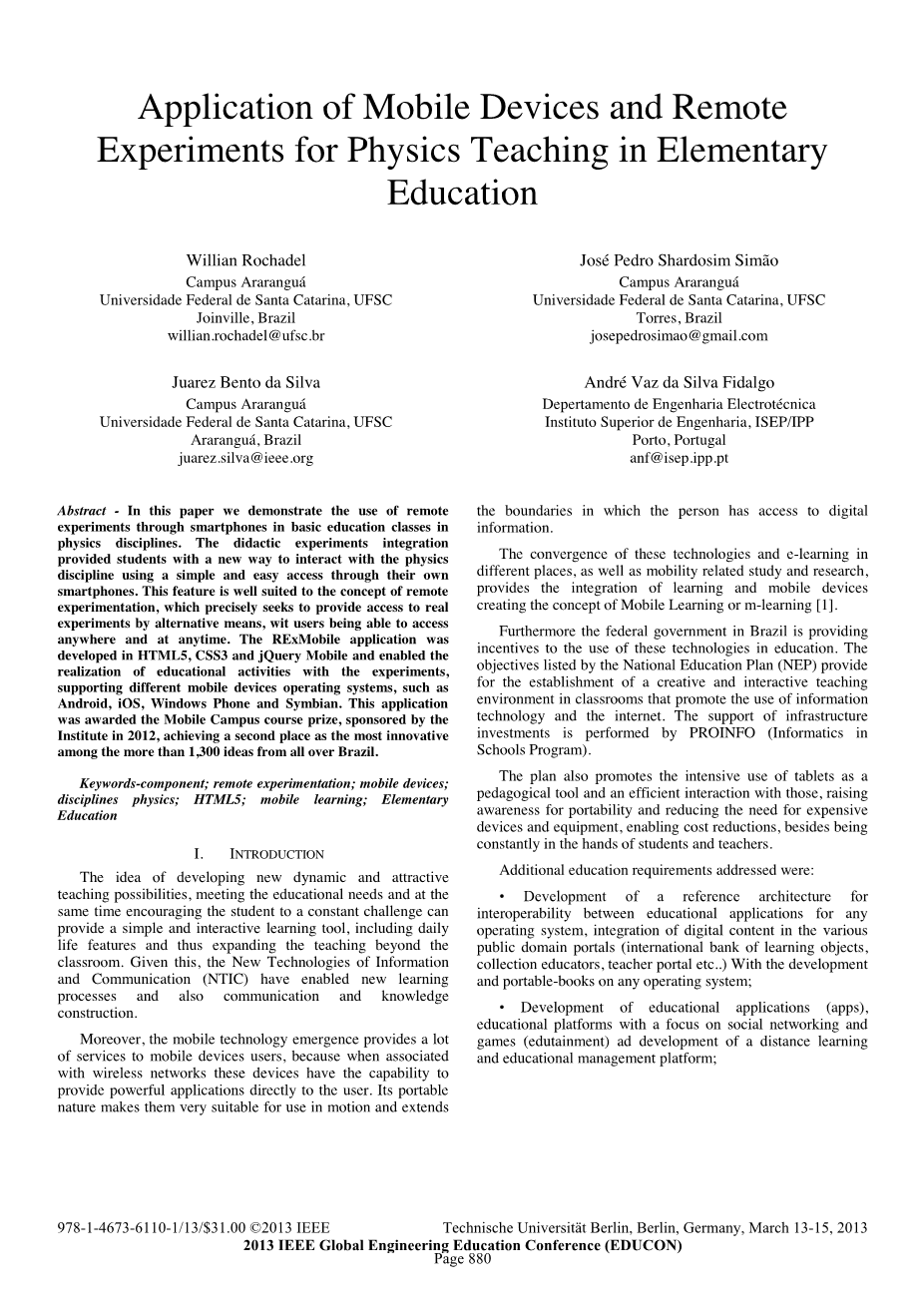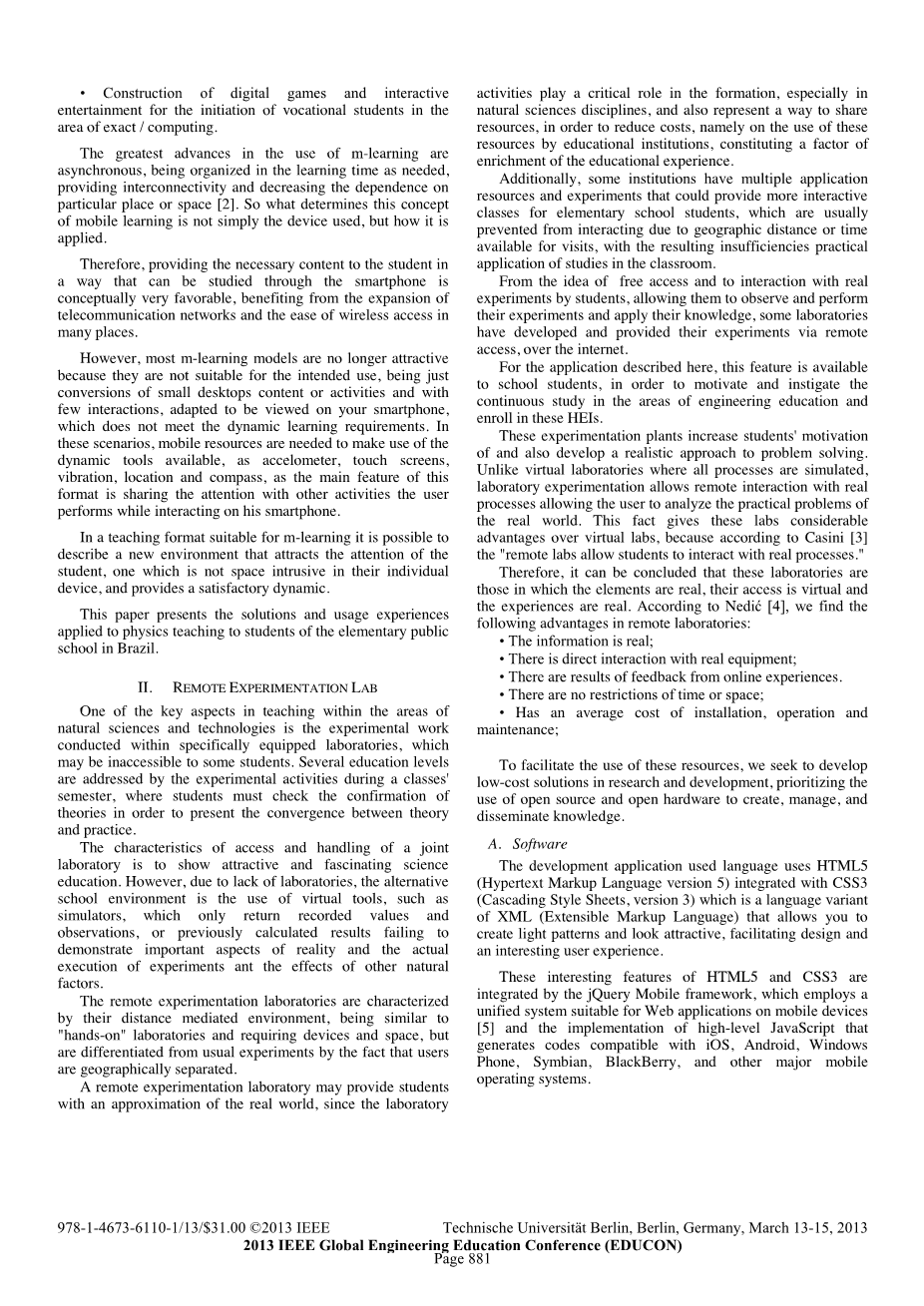本科毕业设计(论文)
外文翻译
Application of Mobile Devices and Remote Experiments for Physics Teaching in Elementary Education
作者:Willian Rochadel,Juarez Bento da Silva,Joseacute; Pedro Shardosim Simatilde;o,Andreacute; Vaz da Silva Fidalgo
国籍:Brazil
出处:2013 IEEE Global Engineering Education Conference (EDUCON)p.880-885
Abstract - In this paper we demonstrate the use of remote experiments through smartphones in basic education classes in physics disciplines. The didactic experiments integration provided students with a new way to interact with the physics discipline using a simple and easy access through their own smartphones. This feature is well suited to the concept of remote experimentation, which precisely seeks to provide access to real experiments by alternative means, wit users being able to access anywhere and at anytime. The RExMobile application was developed in HTML5, CSS3 and jQuery Mobile and enabled the realization of educational activities with the experiments, supporting different mobile devices operating systems, such as Android, iOS, Windows Phone and Symbian. This application was awarded the Mobile Campus course prize, sponsored by the Institute in 2012, achieving a second place as the most innovative among the more than 1,300 ideas from all over Brazil.
Keywords-component:remote experimentation; mobile devices; disciplines physics; HTML5; mobile learning; Elementary Education
Ⅰ.INTRODUCTION
The idea of developing new dynamic and attractive teaching possibilities, meeting the educational needs and at the same time encouraging the student to a constant challenge can provide a simple and interactive learning tool, including daily life features and thus expanding the teaching beyond the classroom. Given this, the New Technologies of Information and Communication (NTIC) have enabled new learning processes and also communication and knowledge construction.
Moreover, the mobile technology emergence provides a lot of services to mobile devices users, because when associated with wireless networks these devices have the capability to provide powerful applications directly to the user. Its portable nature makes them very suitable for use in motion and extends the boundaries in which the person has access to digital information.
The convergence of these technologies and e-learning in different places, as well as mobility related study and research, provides the integration of learning and mobile devices creating the concept of Mobile Learning or m-learning [1].
Furthermore the federal government in Brazil is providing incentives to the use of these technologies in education. The objectives listed by the National Education Plan (NEP) provide for the establishment of a creative and interactive teaching environment in classrooms that promote the use of information technology and the internet. The support of infrastructure investments is performed by PROINFO (Informatics in Schools Program).
The plan also promotes the intensive use of tablets as a pedagogical tool and an efficient interaction with those, raising awareness for portability and reducing the need for expensive devices and equipment, enabling cost reductions, besides being constantly in the hands of students and teachers.
Additional education requirements addressed were:
- Development of a reference architecture for interoperability between educational applications for any operating system, integration of digital content in the various public domain portals (international bank of learning objects, collection educators, teacher portal etc..) With the development and portable-books on any operating system;
- Development of educational applications (apps), educational platforms with a focus on social networking and games (edutainment) ad development of a distance learning and educational management platform;
- Construction of digital games and interactive entertainment for the initiation of vocational students in the area of exact / computing.
The greatest advances in the use of m-learning are asynchronous, being organized in the learning time as needed, providing interconnectivity and decreasing the dependence on particular place or space [2]. So what determines this concept of mobile learning is not simply the device used, but how it is applied.
Therefore, providing the necessary content to the student in a way that can be studied through the smartphone is conceptually very favorable, benefiting from the expansion of telecommunication networks and the ease of wireless access in many places.
However, most m-learning models are no longer attractive because they are not suitable for the intended use, being just conversions of small desktops content or activities and with few interactions, adapted to be viewed on your smartphone, which does not meet the dynamic learning requirements. In these scenarios, mobile resources are needed to make use of the dynamic tools available, as accelometer, touch screens, vibration, location and compass, as the main feature of this format is sharing the attention with other activities the user performs while interacting on his smartphone.
In a teaching format sui
剩余内容已隐藏,支付完成后下载完整资料


英语原文共 6 页,剩余内容已隐藏,支付完成后下载完整资料
资料编号:[276702],资料为PDF文档或Word文档,PDF文档可免费转换为Word
以上是毕业论文外文翻译,课题毕业论文、任务书、文献综述、开题报告、程序设计、图纸设计等资料可联系客服协助查找。


